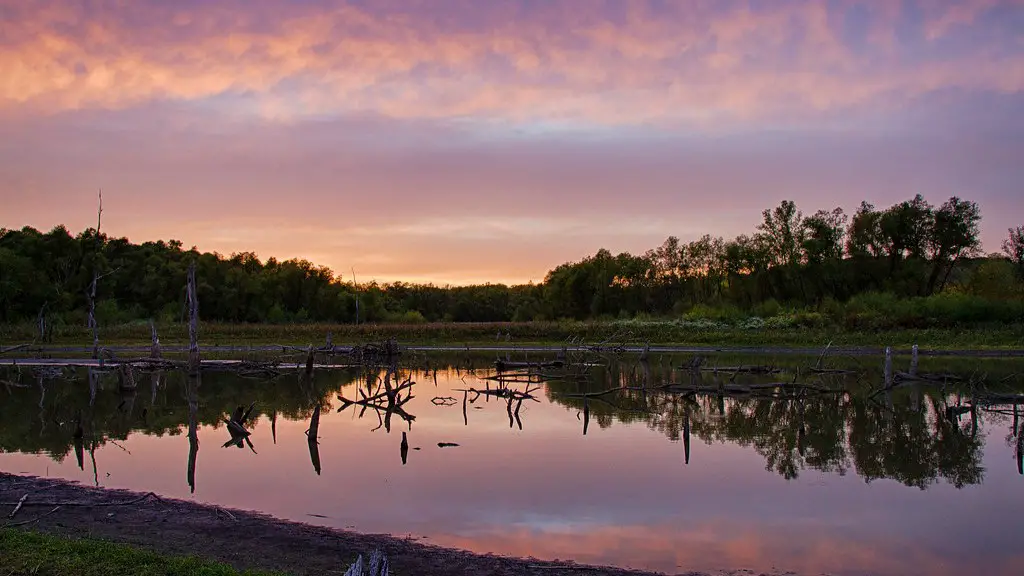The Mississippi River is home to the nation’s primary barge transportation system for commodities, but recent reports have indicated the river is becoming more quiet. The traffic along the river has declined, causing not only economic implications for the businesses that rely on the trade, but also increased environmental hazards from the smaller barges and other vessels that now fill their place.
Between 2014 and 2017, the amount of barge anchoring along the Mississippi River has dropped by 40%. This drop is attributed to many factors, including an increase in competition from road, truck, and rail transportation. In addition, the fluctuations in commodity prices on the commodities traded on the river have caused demand to decrease, meaning fewer barges are needed to transport them. The drop in the amount of barge use has had a ripple effect on the river, impacting citizens, businesses, and the environment.
For businesses dependent on the barge traffic, the decrease in trade has been a significant blow. Chris Unverzagt, Executive Director of the Upper Mississippi Waterway Association, states that “It’s estimated that if these river traffic numbers continue to decline, it could cost the regional businesses up to $12 billion annually in lost revenue.” The ripple effects these businesses will feel are vast and significant, including reductions in their downstream dependent employment.
Citizens who live along the river face a different problem- the small vessels and barges that have begun to take the place of the larger ones. Dustyn Dinkins, a resident of Memphis on the Mississippi, says that “Since the large barges don’t frequent the river as much, it has opened up the area for smaller vessels and boats, making navigation of the river a hazardous situation”. The increased density of vessels has caused congestion, as well as other threats such as pollution and strain on the ecosystem.
The environmental impact of the reduced barge traffic is difficult to measure, however it can be hypothesized that the increase in smaller vessels has caused the pollution levels in the river to increase. In addition, the lack of the large barges has caused an increase in erosion along the riverbanks. These two issues have become top concerns for the locals living near the area, as both have been linked to health risks.
The reduced barge traffic on the Mississippi River is a phenomenon with multiple implications. Businesses relying on the river for the transportation of their goods have felt the economic strain, citizens along the river worry about the environmental risks, and the river itself stands to suffer longterm damage.
Barge Traffic Regulations
In order to manage the declining amount of barge traffic along the Mississippi River, regulations have been put in place. The River Resource and Recovery Act, which passed in 2019, provides regulations on the navigation of the river, as well as how much pollution vessels can legally produce.
The Act has specific stipulations that directly influence the amount of barge traffic the city buses. For instance, the minimum speed of barge traffic has been increased from seven to eight knots in order to reduce congestion. This increase in speed has been estimated to reduce the amount of barge traffic by as much as five percent.
In addition, the Act also sets limits on the size of vessels that can travel along the river. This measure is intended to reduce the amount of pollution created by the vessels, as smaller vessels often produce more exhaust than their large counterparts.
These regulations have been effective in reducing the amount of barge traffic along the Mississippi River, however the congestion issue remains. The regulations were put in place in order to manage the decline of this important mode of transportation and to limit its environmental impact.
Opposition to Mississippi Barge Traffic Regulations
When the Mississippi River Resource and Recovery Act was put into place, it was met with resistance from a variety of sources. The most vocal opponents were those that relied on the Mississippi River for their livelihood, including the Upper Mississippi Waterways Association (UMWA).
This organization argued that the regulations were too strict, which would lead to higher costs and less business for the companies that relied on the barge traffic. The UMWA also raised concerns about the economic impact of the regulations and the amount of jobs that would be lost as a result.
Ultimately, the regulations were passed, despite the opposition from the UMWA. These regulations have had an immediate effect on the amount of barge traffic along the Mississippi River, however their longterm effects are still unknown.
Opportunities to Increase Barge Traffic
In light of the decline in barge traffic, some organizations are proposing solutions to increase it. One such solution is the development of public-private partnerships, which would enable businesses to operate more efficiently and minimize their carbon footprint.
The UMWA has spearheaded this solution and is attempting to build relationships between businesses, governments, and investors in order to bring more business to the area. They have also created a number of initiatives to help companies transition to a more efficient, environmentally conscious way of operating.
Another opportunity to increase barge traffic is through the use of alternative fuels. Organizations such as the Environmental Defense Fund have proposed that businesses transition away from traditional fossil fuels and instead use alternative fuels that produce lower emissions.
The use of these alternative fuels could drastically reduce the amount of pollution produced by the vessels, as well as reduce the amount of money it takes to operate them. With the right incentives in place, businesses could make the switch to eco-friendly fuels and in turn, create a positive effect on the amount of barge traffic.
Costs of Increased Barge Traffic
Though much effort has been put into increasing the amount of barge traffic along the Mississippi River, doing so is costly. Not only does the cost of fuel for the vessels have to be taken into account, but also the cost of maintaining the river itself.
The government has put in place a number of initiatives to upkeep the river throughout the year, including dredging projects, repairs of locks and dams, and the cleaning up of pollution. All of these projects are costly, and require a significant amount of funding from the government in order to be successful.
In addition to these costs, businesses must also take into account the cost of insurance for their vessels. The amount of insurance required depends on the size and nature of the vessel, which can add significantly to the price of operation. For larger vessels, such as barges, the cost of insurance is often times too high, making the operation of these vessels difficult.
Economic Implications of Increased Barge Traffic
Increases in the amount of barge traffic along the Mississippi River would have a significant effect on the local economy. An increase in trade would create job opportunities, as well as provide economic benefits for businesses operating along the river.
In addition, the number of tourists visiting the area would likely increase. Tourism is an important industry for the Mississippi River, and an increase in traffic would make it easier for tourists to get to the area. This could lead to increased spending in the local businesses, leading to an overall increase in revenue.
Furthermore, increased barge traffic could also lead to increased investment opportunities in the area. Many investors see the potential of the area, and an increase in trade could make it more attractive to potential investors. This could lead to increased economic growth, as well as more job opportunities for those living along the river.
Conclusion of Barge Traffic on The Mississippi River
Overall, the amount of barge traffic on the Mississippi River has decreased significantly in recent years. This change has brought about many implications, from economic to environmental, as well as increased regulations in order to manage the decline.
In light of the decrease, some organizations have proposed solutions for bringing the amount of barge traffic back to its former levels. These solutions include the development of public-private partnerships, the use of alternative fuels, and increased incentives for businesses to operate in a more sustainable way.
Despite the efforts being put forth to increase barge traffic, the amount of traffic on the river is still significantly lower than it once was. The longterm effects of this decline are still unknown, and only time will tell how this phenomenon will shape the area in the coming years.





